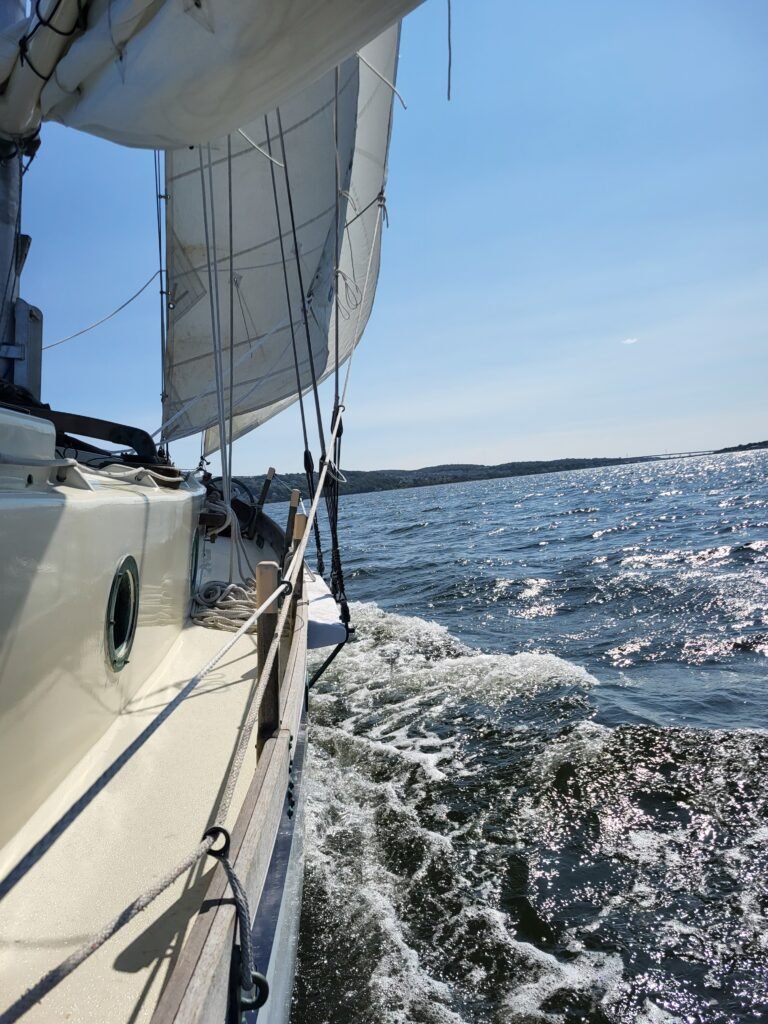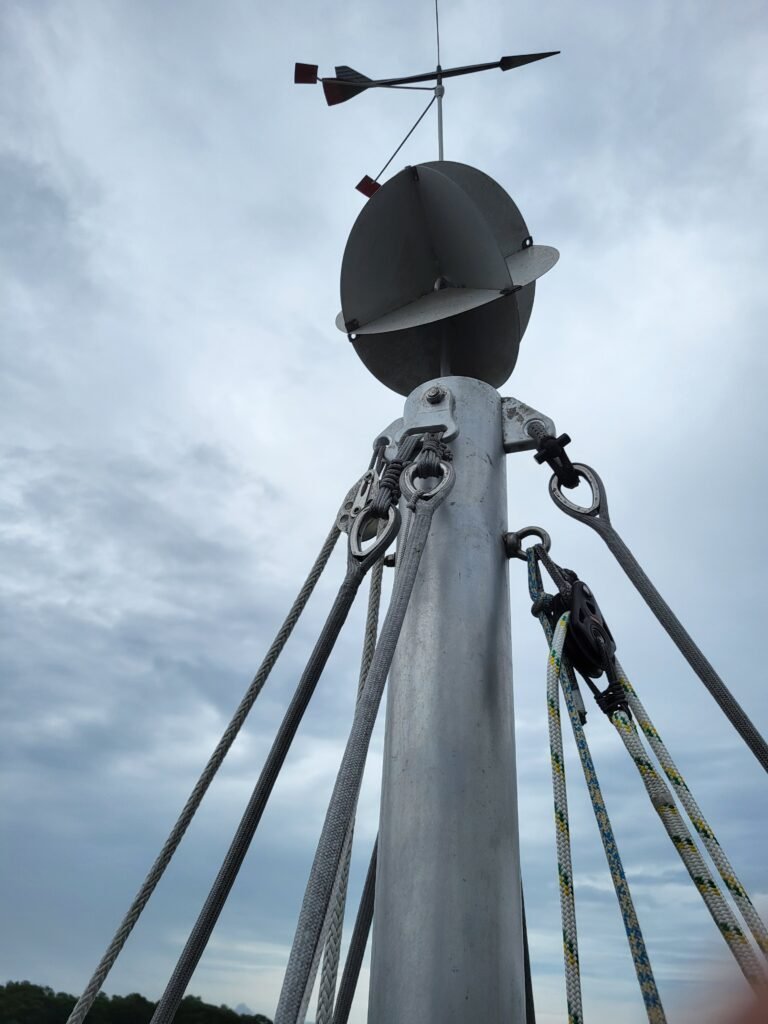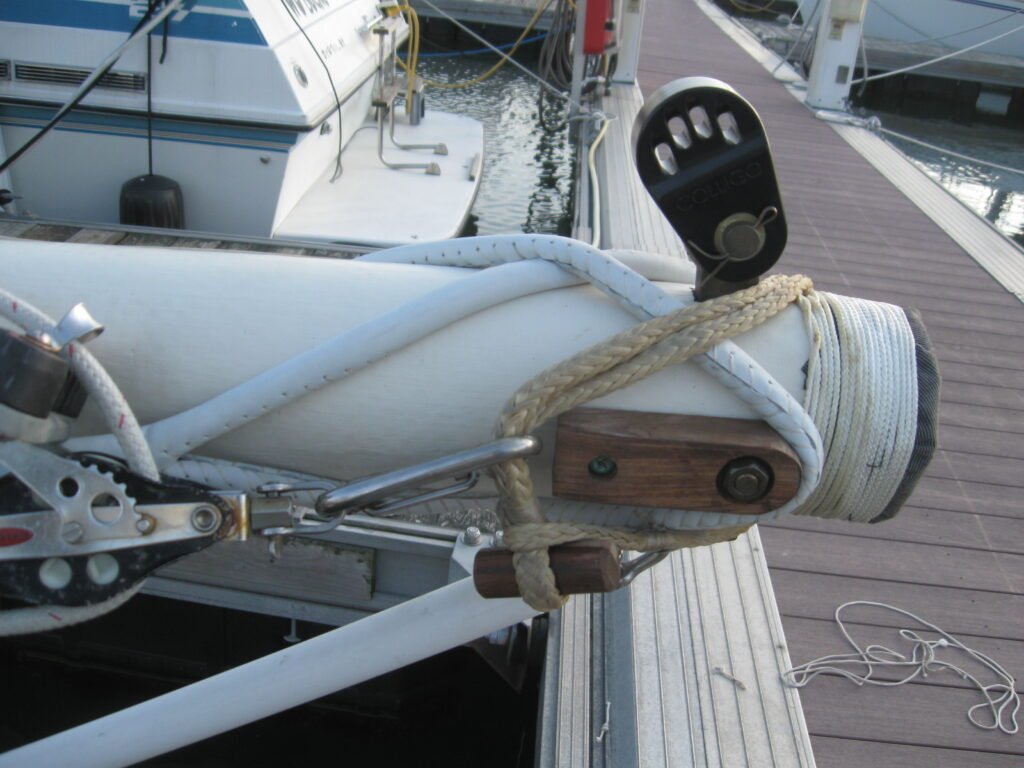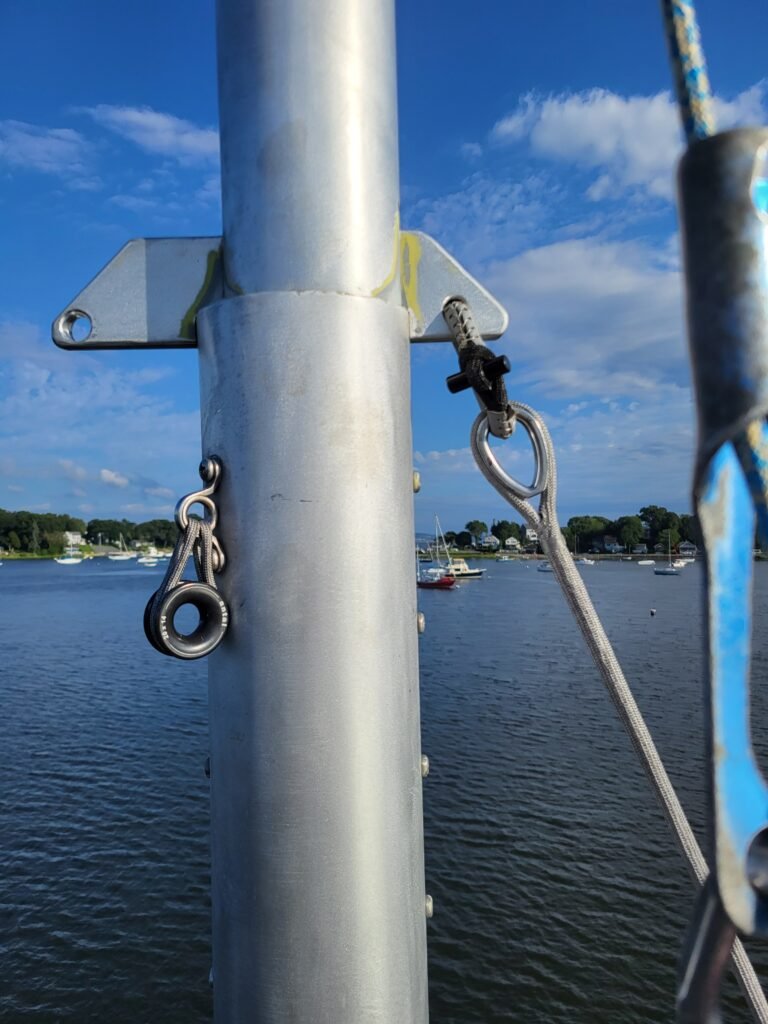

When we first rigged Ganymede’s light-pole mast back in 2009, we used Vectran-cored rope for standing rigging. Of the other options, Kevlar was too curmudgeonly, PBO was too expensive and short-lived, and Dyneema as a standing rigging fiber was still in its infancy. The Vectran was easy to work with, affordable, and most of all, stable: in twelve years of hard sailing we never had issues with the molecular creep common to dyneema.
The big downside to Vectran, though, is that it suffers significant UV degradation, even inside of a polyester cover. After a decade in the sun, the old forestay I break-tested had lost 30% of its original rated strength. Still, being oversized (I got a bargain on spool ends), there was plenty of strength left by the time we retired it in favor of the newest variety of Dyneema, DM20. Heat-set and pre-stretched DM20 is engineered to eliminate the creep of SKs 75,78, and 99, trading some strength for stability. No one really knows how it will behave long-term, but we figured someone has to take the plunge, and we needed to move on from our aging Vectran.

Years of working in rope shops and our experience with Ganymede’s rig gave me the wherewithal to design and build the new gang of rigging better, I trust, and more streamlined than the last. One major change was to make each piece individually removable. Before, the lowers, cap shrouds, and runners had big leathered eyes that went around the mast, one on top of the other in sequence. Very traditional, but the mast had to be down in order to slip them over the masthead and onto their bolsters. This time I made loops with a toggled closure to go around the mast and engage a spliced eye with a thimble. More parts, I know, but now each shroud can be individually removed without disturbing the others or unstepping the mast.

At the masthead, the jumble of overlapping loops has been replaced by bolt-on tangs I designed to receive synthetic shrouds. This first version of the “Lashing Tang,” which I had water-jet cut from aluminum plate, radiused with a carbide-tipped router (scary!), and finally bent with a heavy vise, is double-wide to receive two lashings: those of the cap shrouds and running backstays.

The last big change was to widen and round-over all the holes in the fittings for the stays and halyard blocks to accept a soft loop and eliminate the stainless steel shackles used before. It may not be quantifiably better, nor be a measurable weight decrease, but it eliminates metal-on-metal contact in favor of soft attachments.
There are a few advantages to soft attachments: they spread the load over an area larger than the bearing surface of a pin; they don’t wear out and abuse the hole like shackles tend to if there’s any play or sideways motion; and finally, they don’t need any messy Tef-gel. It might seem like a solution searching for a very small problem, but again: we’re making incremental improvements that, if they do nothing other than spark joy when I go aloft, are still worth doing.

Even though Dyneema is very UV stable, in order to protect it further I slid some Dyneema cover over each shroud before splicing it. Instructions for the correct way to do this splice, with all the ends tidied away inside, were impossible to find when we made the first gang of rigging. Various means of hiding the cover flap were in vogue, though none of them was really elegant. By the time I started doing those splices for a living, half a decade later, the method was still kind of a rigger’s secret. You can now find instruction for it HERE. Because Dyneema cover is easier to work with than polyester cover, being thinner and less tight, it didn’t take long to put together a gang of shrouds. At the lower end, I re-used the Colligo Marine deadeyes. At the upper ends are spliced some heavy-duty stainless steel thimbles meant for wire rope, to engage the detachable covered loops. This way there’s no metal-on-metal contact between shrouds and mast.
Each shroud got pre-stretched between two trees, using a Spanish Burton to double the load on the come-along, and then dyed a discreet gray with Marlow’s Armourcoat. Rope dye not only colors and offers UV protection, but keeps strands from snagging, thus reducing chafe. Marvelous stuff.
How to tighten lanyards enough was always a conundrum: in times past I had led the fall of the lanyard from the lower deadeye to a tackle on a halyard, twanging each leg of the lanyard in turn to get slack out while heaving bravely on the tackle fall. It worked, but required much effort. This time, I hung a Dyneema line from the masthead, attached the come-along to the bottom, and ratcheted the lanyards tight with little effort. It was scary how easily too much tension could be produced if I wasn’t careful with the ratchet. A Spanish windlass improvised with a loop and a belaying pin kept the lanyard legs from slipping back while we took the come-along off and hitched off the tail.




The deadeyes and lanyard on the bowsprit end had always kept the jib from stowing low enough to see past. An extra-long jibstay, passed through a thimble on a strop at the bowsprit end and deadended to an eyebolt under the sprit has solved that problem. Now the jib downhaul pulls the sail tight against the bowsprit, making everything neater and less baggy.

There are still things to tweak and things to improve, but having sailed pretty hard several times in New England’s autumn breezes, the rig has given complete satisfaction. I’ll post follow-ups as time goes by and issues arise, but for now I’m cautiously optimistic about Ganymede’s new synthetic rigging. It’s good to know that as far as the boat is concerned, we could take off and go cruising again tomorrow.

